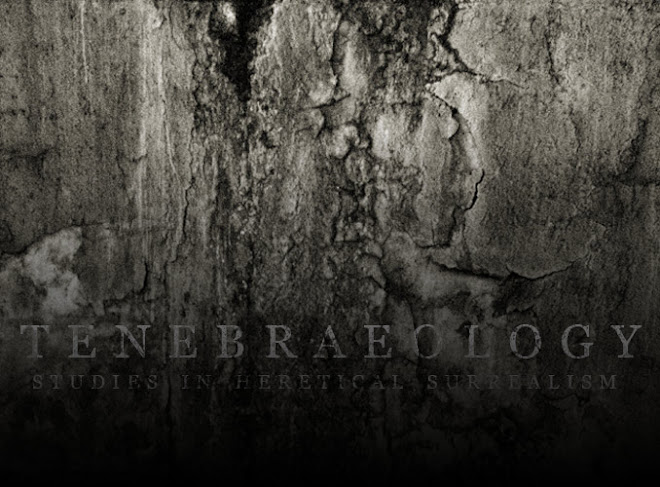Despite their ostensibly antithetical properties, there is a profound link between macabre aesthetics and works of humorous nonsense. The latter, traditionally presented in the context of literary nonsense, is often associated with mere amusement. It has much more complex implications, however, and embodies principles similar to those of gothic imagery.
The connection between the macabre and nonsense is darkness, which is a rich metaphor loaded with manifold cultural meanings. The most literal and fundamental of these is that of unlit spaces. Modern life, especially in cities, has lost much of its ancient relationship with light and shadow. Before the ubiquitous and unceasing presence of electric light, the absence of illumination was much more threatening. The predators of the nocturnal wilderness, both human and beast, could stalk their victims or prey unseen under the void of the new moon. Elsewhere, faint light could trick the eyes so that harmless objects were transformed into menacing spectres. The human brain, designed to recognize patterns and forms, will tend to find its own grotesque truths at the threshold between perception and mystery.
The human imagination is a synthesis of memory and possibility. It provides access to a spectrum ranging from the realistic to the absurd to the mystical. Fueled by the unknown, the imagination is able to conjure equal portions of pleasure and horror. It is horror that inspires stronger emotions, however, as it is more connected to vital instincts. Humorous absurdity, which relies on more intellectual processes, has less to do with human survival than the macabre. Thus even the most lighthearted products of culture have currents of dread coursing through them.
There is an abundance of horror in even superficial readings of the highly refined nonsense penned by Lewis Carroll. A highly advanced, professional mathematician, Carroll invokes darkness through a calculated upsetting of the intellect. His darkness is the result of intellectual collisions. Lewis Carroll utilizes logic to its own detriment and for our amusement. This reliance upon intellectual rigor distances Carroll from the darkness he unleashes.
Edward Lear, born twelve years before Lewis Carroll, dealt with a much purer nonsense imbued with a more rarefied apprehension and a more immediate delight. His Book of Nonsense was first published in 1846, nineteen years before the publication of Carroll’s Alice’s Adventures in Wonderland. His exceedingly absurd poems and limericks are accompanied by his own deliberately crude illustrations. The might of his pen is found not at the writing end of the quill, but in the feather, which he uses to tickle our minds—violently. His line drawings plunge the imagination into the inky depths of its own abyssal well.
The brash silliness of Lear's verse and illustration betrays a gleefully sadistic treatment of rational forms that came as naturally to Lear as it does to his intended audience—children. This cathartic violation fulfills Lear’s fantasy of disturbing the Victorian era’s God-induced sobriety, which he expressed directly in proclaiming that “The uniform apathetic tone assumed by lofty society irks me dreadfully” continuing, “nothing I long for half so much as to giggle heartily and to hop on one leg down the great gallery—but I dare not” (Edward Lear, by Angus Davidson, p. 17). This impish impulse is sublimated in his nonsensical creations, which rank highly as examples of violent , yet indulgent illogicalism.
By shrouding literal or abstract perceptions, darkness opens a door to legion possibilities, to multifarious fragments of inexhaustible chaos. At opposing poles of emotional responses to this limitlessness are delirious ecstasy and consuming despair.
The yield of these principles, explored through nonsense literature's playful reconciliation of opposites, is as boundless as the tunnel perceived in mirrors that, facing each other, show opposite sides of the object between them, simultaneously and continuing beyond possible comprehension.
Imagination is the sole domain of abstractions, regardless of their rationalism or absurdity. What, however, are the limits of the imagination? The imagination does not have limitless power. Even if we were armed with an inconceivable set of senses other than those currently available to us, imagination would possess an infinite store of possibilities just as it does now. It is the constant presence of the unknown as a variable in an equation equaling infinity that ensures the immortality of imagination in the conscious mind. The only threat to imagination is omniscience.
Subscribe to:
Post Comments (Atom)

1 comment:
An interesting article. The heretical valorization of black light has its own surrealist frisson. The view of the abyss as a psychic sensor or a symbol for 'going too far' is symptomatic of a defense mechanism against the unconscious...A more orgonomic view involving surrender to the streamings, and honesty before the self, promotes atheistic, profane illumination or gnosis in the face of cultural restraint. In this sense the nonsense writers use of black humor was adversarial to their time periods and could be seen as plunging us into the abyss of unlimited possibilities, against one-dimensional character armored identities. Concerning other articles on your blog, I'd not thought about parallels between surrealism and satanism in such an obviously referenced way, but your site certainly comes across as more convincing and genuinely interesting than Lutheran Surrealism, for example!
Post a Comment